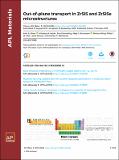Files in this item
Out-of-plane transport in ZrSiS and ZrSiSe microstructures
Item metadata
| dc.contributor.author | Shirer, Kent R. | |
| dc.contributor.author | Modic, Kimberly A. | |
| dc.contributor.author | Zimmerling, Tino | |
| dc.contributor.author | Bachmann, Maja D. | |
| dc.contributor.author | König, Markus | |
| dc.contributor.author | Moll, Philip J.W. | |
| dc.contributor.author | Schoop, Leslie | |
| dc.contributor.author | Mackenzie, Andrew P. | |
| dc.date.accessioned | 2019-11-05T17:30:03Z | |
| dc.date.available | 2019-11-05T17:30:03Z | |
| dc.date.issued | 2019-10-17 | |
| dc.identifier | 262778225 | |
| dc.identifier | 8bcd22ad-820c-4a37-a601-996ec66825cc | |
| dc.identifier | 85073789052 | |
| dc.identifier | 000509790200021 | |
| dc.identifier.citation | Shirer , K R , Modic , K A , Zimmerling , T , Bachmann , M D , König , M , Moll , P J W , Schoop , L & Mackenzie , A P 2019 , ' Out-of-plane transport in ZrSiS and ZrSiSe microstructures ' , APL Materials , vol. 7 , no. 10 , 101116 . https://doi.org/10.1063/1.5124568 | en |
| dc.identifier.issn | 2166-532X | |
| dc.identifier.other | ORCID: /0000-0002-1075-3888/work/64361323 | |
| dc.identifier.uri | https://hdl.handle.net/10023/18855 | |
| dc.description | K.R.S., M.K., P.J.W.M., and A.P.M were supported by the Max-Planck-Society. P.J.W.M. acknowledges support by the Swiss National Science Foundation (Grant Nos. PP00P2_176789). M.D.B. acknowledges studentship funding from EPSRC under Grant No. EP/I007002/1. Work at Princeton was supported by NSF through the Princeton Center for Complex Materials, a Materials Research Science and Engineering Center Grant No. DMR-1420541. | en |
| dc.description.abstract | A recent class of topological nodal-line semimetals with the general formula MSiX (M = Zr, Hf and X = S, Se, Te) has attracted much experimental and theoretical interest due to their properties, particularly their large magnetoresistances and high carrier mobilities. The plateletlike nature of the MSiX crystals and their extremely low residual resistivities make measurements of the resistivity along the [001] direction extremely challenging. To accomplish such measurements, microstructures of single crystals were prepared using focused ion beam techniques. Microstructures prepared in this manner have very well-defined geometries and maintain their high crystal quality, verified by the observations of quantum oscillations. We present magnetoresistance and quantum oscillation data for currents applied along both [001] and [100] in ZrSiS and ZrSiSe, which are consistent with the nontrivial topology of the Dirac line-node, as determined by a measured π Berry phase. Surprisingly, we find that, despite the three dimensional nature of both the Fermi surfaces of ZrSiS and ZrSiSe, both the resistivity anisotropy under applied magnetic fields and the in-plane angular dependent magnetoresistance differ considerably between the two compounds. Finally, we discuss the role microstructuring can play in the study of these materials and our ability to make these microstructures free-standing. | |
| dc.format.extent | 7 | |
| dc.format.extent | 2364398 | |
| dc.language.iso | eng | |
| dc.relation.ispartof | APL Materials | en |
| dc.subject | QC Physics | en |
| dc.subject | Materials Science(all) | en |
| dc.subject | Engineering(all) | en |
| dc.subject | NDAS | en |
| dc.subject.lcc | QC | en |
| dc.title | Out-of-plane transport in ZrSiS and ZrSiSe microstructures | en |
| dc.type | Journal article | en |
| dc.contributor.institution | University of St Andrews. School of Physics and Astronomy | en |
| dc.contributor.institution | University of St Andrews. Condensed Matter Physics | en |
| dc.identifier.doi | https://doi.org/10.1063/1.5124568 | |
| dc.description.status | Peer reviewed | en |
This item appears in the following Collection(s)
Items in the St Andrews Research Repository are protected by copyright, with all rights reserved, unless otherwise indicated.

